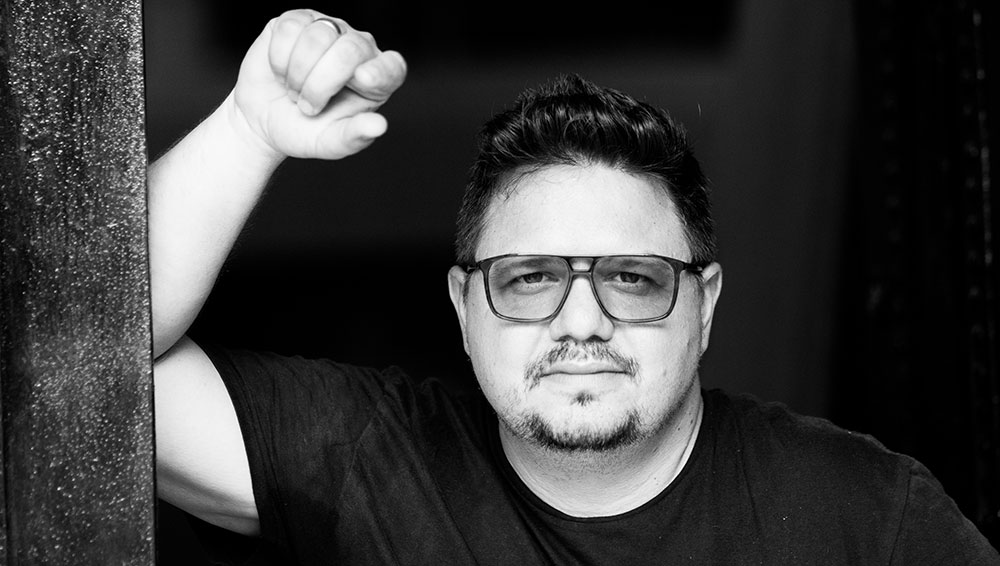
Yoan Capote. Photo: Leandro Feal.
by ANNA McNAY
Yoan Capote (b1977, Pinar del Río, Cuba) makes work that addresses social and political issues of a timeless nature. Coming from and working in Cuba, he is haunted by a history of migration, and this is something he frequently refers to in his work. He makes paintings, sculptures and photographs in which representations of landscape and the sea become metaphorical illustrations of psychological or emotional experiences. He received the Unesco prize during the 7th Havana Biennial, with the artists’ collective DUPP, and he represented Cuba at the 54th Venice Biennale.
-2020-(2).jpg)
Yoan Capote, Requiem, installation view. © Yoan Capote. Image courtesy Ben Brown Fine Arts.
For his third solo exhibition at Ben Brown Fine Arts, London, entitled Requiem, he has made a series of large-scale painted seascapes – some stretching up to three and a half metres across. These comprise multiple panels, like the altarpieces in medieval churches. Again referencing migration and death, they have also, unsurprisingly, been affected by the experience of the pandemic.
Capote spoke to Studio International by email in the run-up to the exhibition.
Anna McNay: Give me a bit of background to the paintings in Requiem. When you paint, do you always paint the sea, or was that just your subject for this exhibition? What made you want to paint it, and are you seeking to capture something literal, or is there a more metaphorical reading to your work?
Yoan Capote: I started working on this new series, entitled Requiem, after my visit to Italy in 2019, where I had the opportunity to take a closer look at works of art from the middle ages and early Renaissance. When I was looking at many of the dramatic scenes depicted in these paintings – the martyrdom of the saints, the final judgment, the expulsion from Paradise – I found many analogies with the suffering, death and anguish of people today. In fact, during that visit, I was very moved by the news about the migrants drowning in the Mediterranean Sea, the heartbreaking images of which bore a sad similarity to what has also happened in the Caribbean Sea. Especially in Cuba, the tragedy of migrants continues to be a visceral issue.
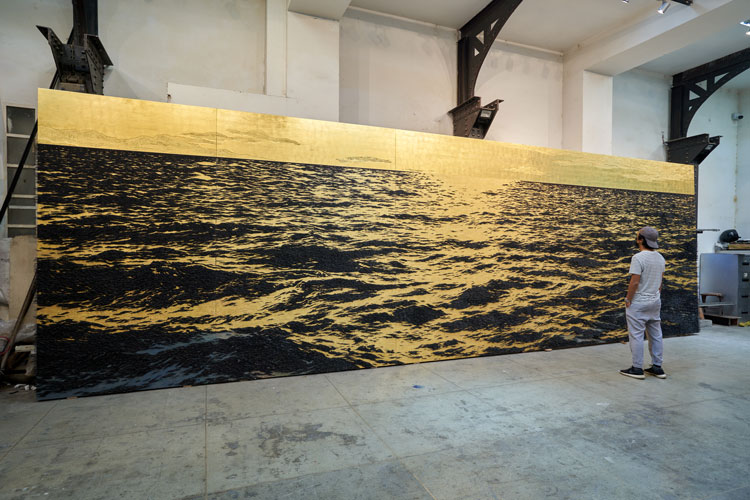
Yoan Capote, Requiem (Plegaria), 2019-21. 24 kt gold leaf, oil, nails and fishhooks on linen panel on plywood, 280 x 909 x 15 cm. © Yoan Capote. Image courtesy Ben Brown Fine Arts.
AMc: What does the sea mean to you?
YC: I have a very emotional relationship with the sea, not only because I live on an island, but also because of all the history and spirituality that it evokes. In Cuba, the sea is related to various Catholic and Afro-Cuban deities. But, above all, when a Cuban looks at the sea, he remembers the isolation and pain of thousands of families, as well as feelings of anxiety, or experiences the psychological frustration of inhabiting a divided country, for which the sea is like a wall or a barbed-wire fence delimiting your destiny.
AMc: What makes you work at such a large scale?
YC: I work at various scales. But it is true that I like to do large-scale works, trying to make the viewer feel embraced by the work and the extension of the horizon. When the public is closer to the piece, they can focus on the aggressiveness and risk of the surface and perceive the real object in dialogue with the representation.
AMc: You frequently incorporate nails and fishhooks into your works. What made you begin to do this? Clearly, they add texture and, clearly, the fishhooks are related to the sea, but tell me more.
YC: Fishhooks are one of the first tools invented by man, an object that has not changed its design for thousands of years. They are universally understood as a symbol of a trap, risk, pain and death. In addition, I am interested in their tactile quality for these works, because, when they are all linked up, they create a metallic surface like an iron curtain or a lacerating wire barrier, which suggests the idea of a border and a political limit, represented by the sea as well.
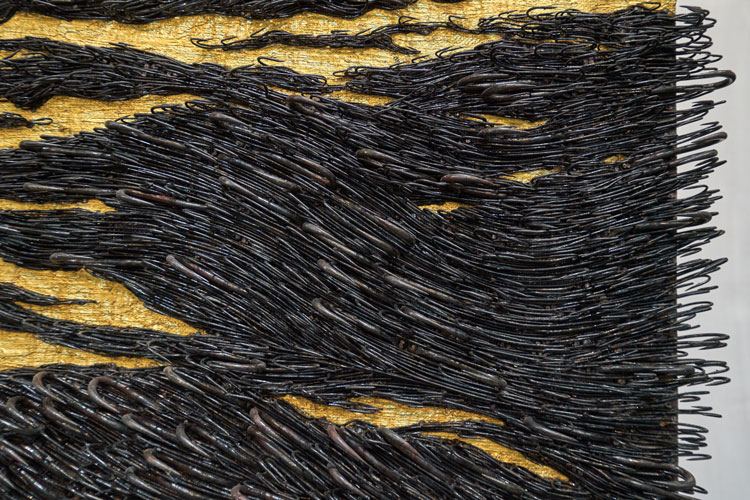
Yoan Capote, Requiem (Plegaria), 2019-21 (fish-hook detail). 24 kt gold leaf, oil, nails and fishhooks on linen panel on plywood, 280 x 909 x 15 cm. © Yoan Capote. Image courtesy Ben Brown Fine Arts.
My first works with fishhooks, in a series entitled Isla, focused on the theme of isolation and migration. However, in this most recent series, which derives from that one, the main theme is death. Of course, this also allows it to include reflections on environmental issues and the death not only of man but of the nature that surrounds us.
AMc: You mentioned creating a metallic surface. Are you seeking to make the painted surfaces more sculptural?
YC: Yes, the experience of the sculpture and the object allows a much stronger tactile and sensory relationship with the viewer, something that is not achieved by 2D painted representation alone.
AMc: For this series, you have introduced gold leaf as well. Where did that idea come from? What do you want to say with it?
YC: Initially, I was inspired by the altarpieces of the middle ages, where gold leaf was used to represent the divine, the purity of heaven, etc. But gold is a material which, in many ancient cultures, was also used to create a spiritual atmosphere conducive to meditation. I was also interested in the similarity of the colour with the tones of sunset, which made me think of Romantic painting and its dramatic and emotional representation of nature.
AMc: Tell me a little about your process. How do you first envisage a painting? Do you work from images in your mind, a view or photographs?
YC: Normally I take photos of the sea at times of the day when the light or the weather seem interesting to me. But I only use these photos in the drawing part, because, when I apply the colours, it is not my main intention to create a painting with a real view, but to transmit an image with visual force. The process of applying the colours is more intuitive and emotional.
-2020---(6).jpg)
Yoan Capote, Requiem (Augurio), 2021 (detail). 24 kt gold leaf, oil, nails and fishhooks on linen panel on plywood, 140 x 200 x 11 cm. © Yoan Capote. Image courtesy Ben Brown Fine Arts.
AMc: You work on panel rather than canvas, and sometimes your works comprise multiple panels. Is this purely a necessity due to their scale, or is there an element of religiosity and wanting to echo the ancient altarpiece and triptych model?
YC: I have always used wooden panels covered in fabric, since, in addition to painting on them, I nail hooks on to their surface. When they are large paintings, I am forced to make polyptychs. In the case of the Requiem series, of course I also value the format and its mode of assembly, inspired by religious triptychs and ancient altarpieces. I was interested in creating altarpieces that show an image of the horizon and the sea. This also made me think of Rothko’s chapel – the idea of making someone meditate not on the represented image, but on what is not represented, or on its absence.
AMc: A further suggestion of religion – or, at least, spirituality – comes from the title of the exhibition – as well as of the individual works for it – namely Requiem. A requiem is a mass for the dead. Who is your mass for?
YC: I believe that death, as a timeless and universal theme, expands the meanings of these works beyond my context, towards other more global topics. Especially today when so many people around the world are dying from the pandemic, and when many species of animals are disappearing. The title Requiem is a tribute or prayer for the dead and disappeared emigrants in my country, but also a prayer for everything that disappears, suffers and dies around the world.
AMc: Your exhibition was planned before – and delayed due to – the pandemic. How, if at all, apart from the reference you just made to the death toll, has the pandemic changed the concept of the show and the works in it?
YC: I think the pandemic has contributed other connotations to the exhibition. The delay in its realisation also allowed me to conceive an extra work, Requiem (Endless Sea), the only sculpture that will be presented. I think this creates a very interesting dialogue with the paintings on the wall. It is a sequence of black granite headstones making a line in the middle of the gallery, joined as a polyptych, the upper part of which recreates the sinuosity and brilliance of the surface of water. The metaphor of the cemetery as a sea evokes the infinite number of deaths we face nowadays.
-2020---(2).jpg)
Yoan Capote, Requiem (Augurio), 2021 (detail). 24 kt gold leaf, oil, nails and fishhooks on linen panel on plywood, 140 x 200 x 11 cm. © Yoan Capote. Image courtesy Ben Brown Fine Arts.
AMc: Just to return to the exhibition title briefly – when I think of a requiem, I tend to think of the musical aspect of the larger whole. Is there a musical aspect to your work? Looking at it, I can imagine being in a gallery, surrounded by the immense seascapes, with a soundtrack of music, and also crashing waves, playing. Maggi Hambling did something similar here in London and Aldeburgh, with the works she had made in response to Benjamin Britten’s War Requiem, displaying them with it playing, which was a completely overwhelming and powerful experience. Can you imagine ever doing anything like that?
YC: In my case, the use of the word requiem is a metaphor. Since my works speak about the victims of migration, isolation, loneliness and affliction, I prefer the solemnity of silence.
AMc: Does that mean you work in silence as well? Or do you listen to music as you work? If so, what was your soundtrack for these paintings?
YC: There is usually a lot of noise in my studio. We can’t listen to music properly with so many people working, talking and hammering at the same time.
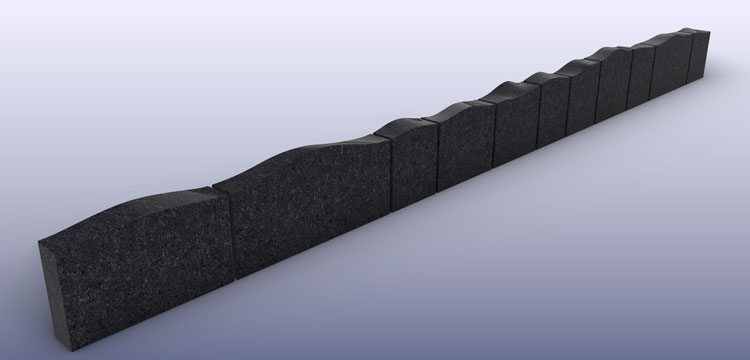
Yoan Capote, Requiem (Endless Sea), 2021. Granite, 11 parts, 64 x 709 x 18 cm (25 1/4 x 279 1/8 x 7 1/8 in). © Yoan Capote. Image courtesy Ben Brown Fine Arts.
AMc: You have mentioned your work’s references to issues of migration, both on a Cuban and international level. Do you seek to make a political comment with your work?
YC: I believe that, in today’s world, everything can be political. Politics decides all aspects of our life. At least in Cuba it is this way, and anything that reflects on society is also addressing the political.
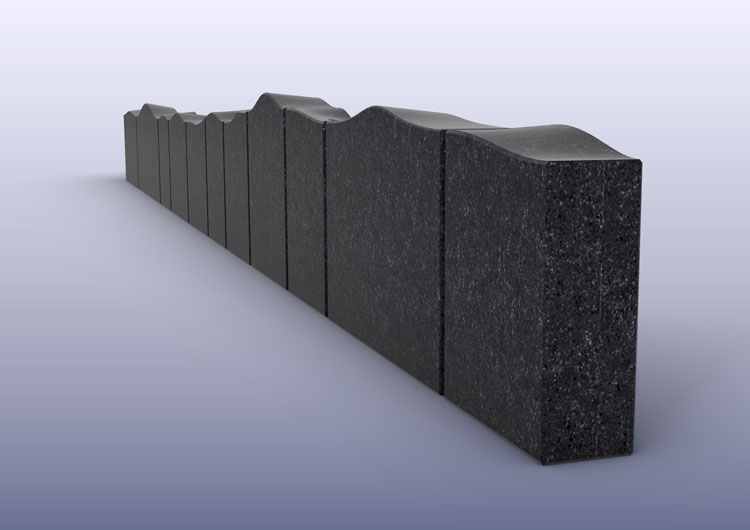
Yoan Capote, Requiem (Endless Sea), 2021. Granite, 11 parts, 64 x 709 x 18 cm (25 1/4 x 279 1/8 x 7 1/8 in). © Yoan Capote. Image courtesy Ben Brown Fine Arts.
AMc: You represented Cuba at the 54th Venice Biennale. Can you say a little about what you showed there?
YC: There were two sculptures, which also touched on the theme of death and migration but from a more existential angle. One work was made from moulds of human bones and was entitled Self-portrait (each one of us). It reflected on resistance and the fragility of life. The other work was called Migrant, and it spoke about displacement and the experience of exile.
AMc: How important is it to you that viewers get to experience your works – in particular, these paintings – in the flesh, and are thus able to sink into their expansiveness and get a real sense of the texture?
YC: For me, the physical experience of a work is very important because I consider it a tool through which to activate the viewer’s feelings and thoughts.
AMc: This is obviously something that has been lost during the pandemic, when so much art viewing has moved online. What are your feelings about this? Is it better to be able to still see and “enjoy” art, or ought one really have that full experience?
YC: Of course, a digital image will never replace the physical experience of a work, but I am one of those people who tries to see the positive side of things. Perhaps this time of the pandemic and social distancing will help us to better appreciate the opportunity to visit a museum or an exhibition and to physically view art with more intimacy and spirituality. What we once took for granted and did in haste, today we can appreciate as a privilege.
AMc: Tell me a little about your artistic training. You studied at the Instituto Superior de Arte (ISA) in Havana. Did you focus on painting or sculpture, or both? How has your practice changed since then?
YC: When I was a student, it was very difficult for me to understand that I had to limit myself to working in a single medium. I liked to experiment with all the different materials and techniques. This remains the case today. I like to work on different types of work at the same time. What gives unity to my work are the themes and content. When I conceive a work, the ideas or meanings are what suggest which material or technique to use.
AMc: This is your third solo show with Ben Brown Fine Arts. As an artist, how do you feel it helps your practice to work consistently with one gallery like this? How does the growth in the relationship – and, presumably, the trust that goes with that – simultaneously encourage and challenge you and your work?
YC: It is a privilege for me to work in a dynamic way with galleries that I admire and that serve their artists in such a special way. Ben Brown and all the gallery staff have been a great support for me, they have helped greatly in the development of both my ideas and my personal life. I have a dialogue with them that is very fruitful for my projects. And the level of the programme that these types of galleries have with other great artists, whom I respect a lot, motivates me to demand more of myself.
AMc: Where do you see yourself heading now? What artistic dreams do you want to fulfil in the coming years?
YC: I like to work on many projects at the same time. I buy empty agendas, and, on the outside, I put the title and the subject of an exhibition I would like to do in the future, rather as a curator might do. Then, in each of those agendas, I make a lot of drawings and develop ideas under each theme. All these agendas are left on my bookshelf waiting for an opportunity.
I work in a random way. In the same week I can be making a bronze sculpture, experimenting with a new material, editing a video, making a watercolour or doing another fishhook painting. I don’t think an artist has to be a pencil that traces a straight line, but a series of lines that expand infinitely from a central point. Each of these lines is a body of works that I develop in unison. It is the exhibitions and events that determine what is going to be exhibited. But I still enjoy keeping working on all my ideas at the same time. This has always been my dream, and I think it has already come true.
• Yoan Capote: Requiem runs at Ben Brown Fine Arts, London, from 15 September to 5 November 2021.